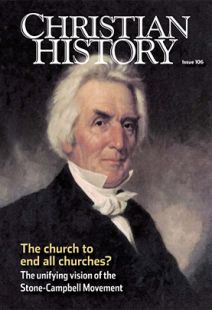Who was that white-robed man?
THERE IS NO MORE colorful character in the annals of the Stone-Campbell Movement than Joseph Thomas, the “White Pilgrim” (1791–1835). Converted to Christ at age 15 at a North Carolina camp meeting in 1806, Thomas determined, then and there, to devote his life to the proclamation of the Christian gospel.
But before he could preach, he felt he must join a church. This proved to be difficult. He rejected the Methodists since they depended too much on the “arbitrary power” of Francis Asbury, their bishop.
He rejected the Freewill Baptists since they had “too many articles and particulars contrary to my impressions.” And finally, he rejected the Presbyterians when they told him that to preach among them, he would “have to go to school and study divinity under Mr. .” Thomas thought it better to “study my divinity under Jesus Christ, and did not join them.”
No rules but the scriptures
Then he learned of the growing “Christian movement” in North Carolina and Virginia. He “went some distance to see one of the preachers” and was elated when the preacher “told me they had no rules but the scriptures” and followed none but “the Lord Jesus for their head and ruler.”
Thomas later recalled that “at hearing of such people as these my heart rejoiced. I said to the preacher, ‘Thy people shall be my people, and thy God my God.’”
On October 19, 1807, having now reached the ripe old age of 16, he set out to preach, committing himself to “a journey not of a few days, a few weeks, or a few months, but as long as life should last.”
Soon Thomas heard of “the Christians in the West”—followers of evangelist Barton Stone, chiefly in Kentucky—and traveled there in 1810. He reported that Stone’s followers numbered some 13,000 believers, that their worship included emotional practices like jerking under the influence of the Holy Ghost, and that they were so devoted to the lordship of Christ that they voluntarily freed their slaves, at a time when such an act was almost unheard of in the American South.
Soon after that trip, Thomas committed to preach in what he viewed as the primitive and apostolic style. He determined, as he put it, to “travel on foot . . . , [to] take nothing for my journey, no purse, nor scrip . . . , [to] deny the present fashion of dress, both as it relates to the cut and the colour, and particularly to refuse black; and a white robe was the covering I should appear in.”
For the rest of his life, Thomas traveled on foot throughout the Blue Ridge Mountains of Appalachia, preaching the gospel and clad in a long, white robe.
By doing so, he embodied in his own life one of the themes most central to the Stone-Campbell Movement—a commitment to the simplicity of the gospel message and to the primitive, apostolic church. CH
By Richard Hughes
[Christian History originally published this article in Christian History Issue #106 in 2013]
Next articles
How to speak Stone-Campbell
What do they mean when they say . . . ?
Douglas A. Foster and McGarvey IceReading the Bible to enjoy the God of the Bible
Connecting the life of the mind to the world of revivalism
Richard HughesNorth and South
Was the division in the “unity movement” as much about geography as theology?
Richard HughesClimbing into the mainline boat
Early Disciples of Christ resisted all “man-made” denominations; so how did some of them become one?
Mark G. ToulouseSupport us
Christian History Institute (CHI) is a non-profit Pennsylvania corporation founded in 1982. Your donations support the continuation of this ministry
Donate



